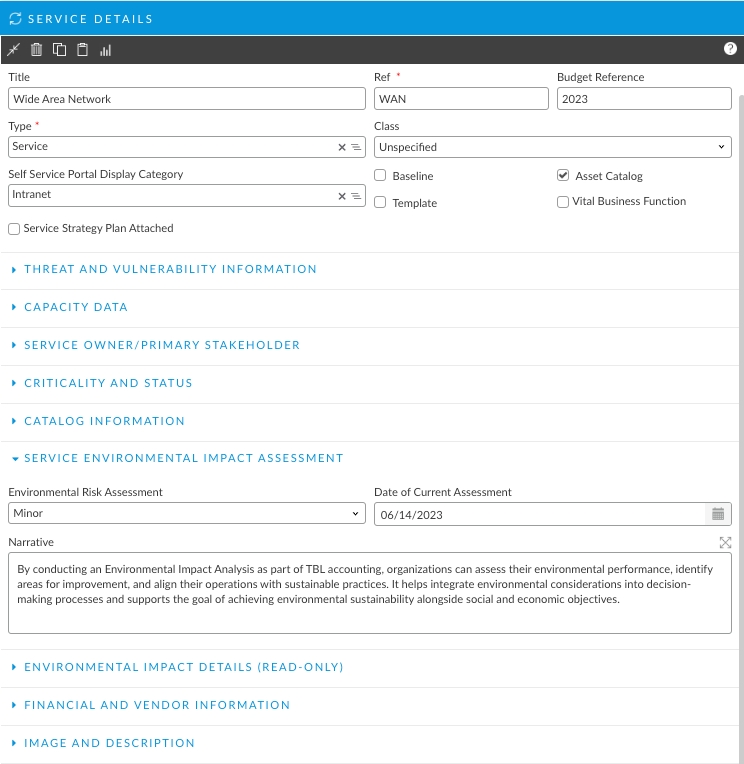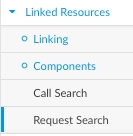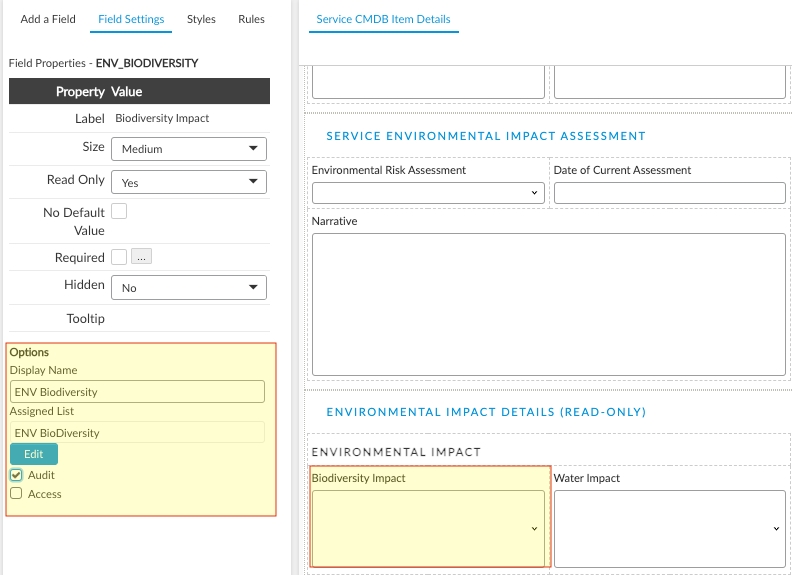Use Cases - Environmental Impact Analysis (for TBL Accounting)
EIA is a method used to measure and account for the environmental impact of business operations alongside social and economic factors.
In TBL (Triple Bottom Line) accounting, an Environmental Impact Analysis (EIA) refers to the process of assessing and evaluating the environmental effects and consequences of an organization's activities, products, or services.
The purpose of conducting an EIA within TBL accounting is to quantify and understand the environmental implications of business practices, enabling organizations to make informed decisions and take appropriate actions to minimize negative environmental impacts. It involves analyzing various aspects of an organization's operations, including resource consumption, emissions, waste generation, and ecological footprint.
The steps involved in conducting an EIA in TBL accounting may include:
Identification and Scope:
Identify the activities, processes, or projects to be assessed.
Define the boundaries and scope of the analysis.
Data Collection:
Gather relevant data related to resource usage, energy consumption, emissions, waste generation, and other environmental indicators.
Use tools such as life cycle assessments, environmental audits, and carbon footprint calculations to collect accurate and comprehensive data.
Impact Assessment:
Evaluate the collected data to assess the environmental impact of the organization's activities.
Identify potential environmental risks, hotspots, and areas of concern.
Quantification and Valuation:
Quantify the environmental impacts using appropriate metrics and units.
Assign values or costs to the impacts to reflect their significance and enable comparison.
Interpretation and Reporting:
Analyze the results of the EIA to gain insights into the organization's environmental performance.
Prepare comprehensive reports and communicate the findings to stakeholders.
Mitigation and Improvement:
Develop strategies and initiatives to mitigate the identified environmental impacts.
Set targets and implement measures to improve the organization's environmental performance.
By conducting an Environmental Impact Analysis as part of TBL accounting, organizations can assess their environmental performance, identify areas for improvement, and align their operations with sustainable practices. It helps integrate environmental considerations into decision-making processes and supports the goal of achieving environmental sustainability alongside social and economic objectives.
Implement Environmental Impact Analysis in ASM
To set up an Environmental Impact Analysis (EIA) workflow in Alemba Service Manager, you can follow these steps:
Define the Workflow Stages:
Identify the stages of the EIA workflow. This could include stages such as "Initiation," "Data Collection," "Impact Assessment," "Mitigation Planning," and "Reporting."
Determine the required actions, approvals, and documentation at each stage.
Configure Custom Forms and Templates:
Create custom forms or templates to capture the necessary information for each stage of the EIA workflow.
Define the fields, data types, and validation rules to ensure accurate data collection.
Include fields for capturing environmental impact assessment data, mitigation strategies, and any other relevant information.
Design Process Flows:
Map out the sequential flow of the EIA workflow using process flows in Alemba Service Manager.
Define the conditions and triggers for transitioning from one stage to another.
Configure automated notifications and reminders to keep stakeholders informed about their tasks and deadlines.
Assign User Roles and Permissions:
Assign appropriate user roles and permissions to ensure that only authorized individuals can access and modify the EIA workflow.
Define roles for initiators, reviewers, approvers, and other stakeholders involved in the analysis process.
Set up access controls to restrict sensitive data to authorized personnel.
Integrate Document Management:
Utilize Alemba Service Manager's document management capabilities or integrate with a document management system to handle EIA-related documents.
Enable file attachments or document linking within the workflow stages for easy reference and collaboration.
Reporting and Analytics:
Configure custom reports and dashboards to provide insights into the EIA process.
Define key performance indicators (KPIs) and metrics to measure the effectiveness of the workflow.
Analyze data and generate reports to monitor environmental impact trends and identify areas for improvement.
Test and Deploy the Workflow:
Validate the EIA workflow by performing thorough testing, ensuring that it meets your organization's requirements.
Gather feedback from stakeholders and make necessary adjustments before deploying the workflow to production.
Training and Communication:
Conduct training sessions to familiarize users with the EIA workflow, its stages, and their responsibilities.
Communicate the purpose and benefits of the workflow to stakeholders and encourage their participation.
By following these steps, you can establish an Environmental Impact Analysis workflow within Alemba Service Manager, enabling efficient management of the EIA process and facilitating environmental sustainability initiatives within your organization.
Example Workflow Template for Environmental Impact Analysis
The workflow template will gather and perform the assessment. The results can be captured on the request and then written to the CMDB Items assessed using a Manage CMDB task. See also:
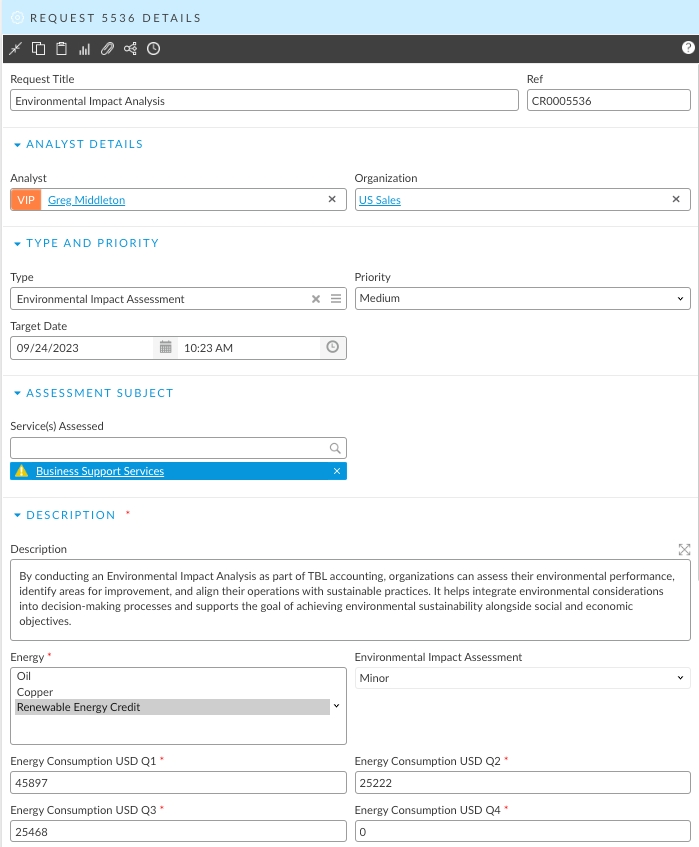
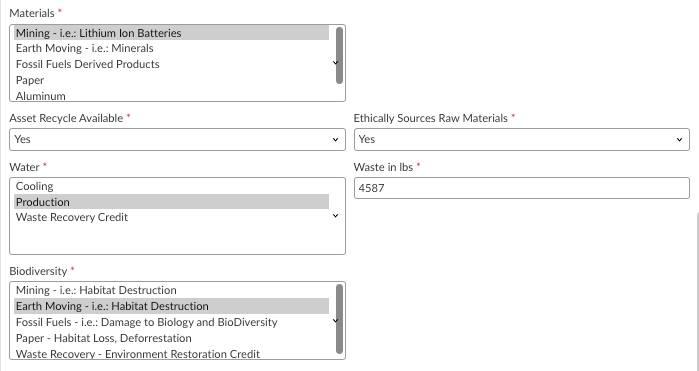
Example Service with an EIA attached
You can update the results of the Environmental Impact analysis directly to the service and therby closing the loop on the assessment. This also exposes the data to the service and allows you to use it for reporting and additional analytics that you will need for your TBL Accounting program.
